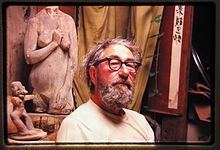Name Joe Funk | ||
 | ||
Died 1981, Santa Cruz, California, United States Education University of Southern California, Chouinard Art Institute | ||
Joseph Funk's 2010 Highlights
Joe Funk (1917–1981) was an American artist and printmaker born in Los Angeles, California in 1914 to Polish and German immigrant parents. He died during the year of 1981 within the city of Santa Cruz, California.
Contents
Life, Work And Notabilities
As a young person in Los Angeles Joe Funk showed an interest in art. He studied at the Otis and Chouinard Art Institutes and worked on several murals throughout Los Angeles in the Works Progress Administration. Joe Funk served the United States Army from 1943 to 1946 in Korea and Okinawa as a heavy anti aircraft artillery mechanic and instructor, warehouseman, and artist/publicist/graphic designer for special events at Headquarters Company, Asiatic Command. At the ASCOM University in Korea he was an instructor in pencil sketching. It was during his time in Korea that he developed a lifelong interest in Asian art. Using the G.I. Bill after the Korean War he earned a Master's Degree in fine art from the University of Southern California.
In the 1950s, Joe met Lynton Kistler and worked at Kistler's facility in Los Angeles, the only lithographic press open for business on the west coast at that time. During his time as an apprentice, Joe printed for many well-known artists, such as Jean Charlot, Man Ray, Max Ernst, Emerson Woelffer and June Wayne.
When June Wayne opened the Tamarind Lithography Workshop in Los Angeles in 1960 she offered the status of 'fellow printer' to Joe Funk. At tamarind he began work printing lithographs for guest artists and training future printmakers.
After Tamarind, Joe became the technical director at Kanthos Press from 1961 to 1962, where he printed for José Cuevas and Aubrey Schwartz. In 1964 he became co-owner of Joseph Press and was printmaker for Sam Francis, Arnold Belkin and Rico Lebrun. From 1962 to 1964 Joe taught at the Chouinard Art Institute.
Joe established a non-profit corporation in Venice, California in the late 1960s called Joseph Graphics. Here he trained apprentice printmakers and printed for numerous artists including Joyce Treiman, Dan Stolpe, and Arnold Schifrin. It was in this period of time that Joe began creating sculptures with found objects such as feathers, bones, leather, other bits of scrap metal, wire, fabric, paper, wood, plastic, pieces of ceramic, rocks, shells, and many other small and large pieces of various manmade and organic materials. He called these sculptures "Funk Icons".
Again in the late 1970s he contributed to several mural projects in Los Angeles funded by the Comprehensive Employment and Training Act grants.
Joe Funk spent his last two years living with cancer. During this time Dan Stolpe gathered all of his artwork and equipment and brought Joe to live with him in Santa Cruz, California where the two of them developed the Native Images printmaking program and facility. A few weeks before his death Joe gave his life's work to Native Images, a collection of art that represents his fifty years as an American artist.
"Joe Funk played a little-known but important role in the development of American lithography during the 1950s and 1960s, first as Lynton Kistler's assistant and later as the initial printer-fellow at Tamarind Lithography Worksop in Los Angeles. That was a time when fine lithographic printing hung by a slender thread in the United States: unlike today, there were then only a very few dedicated printers with knowledge of the craft. Joe was one of this small number, without whom the present health of the medium could not have come about. His easy-going warmth and good nature made it a pleasure to work with him." Clinton Adams, Director Tamarind Institute
Family
Joe Funk was married one time, with two children.
Quotes
The following quotes are the written words of Joe Funk, from the book, Joe Funk, A brief view of the life & work of an artist/master printer, Santa Cruz, California, Aptos Press, 1981.
"Behind this world of fantasy and imagination is a background of academic study and training which is not lost in the desire for excellence. There is symmetry and an order of its own kind based on the artist's feeling that if one is related to people and things in a certain way then the work will become alive and have power. You may call it magic, religious or transcending ordinary appearances. It is ok because these words do hint at this meaning. The pieces are quiet and listening as if time has stopped for them. They are happy to be as they are from now on."
"Call the works romantic, the artist a poet of things. If you want to see this art you have to go to the studio and browse around spending some time at different times of the day and night when the light will change and different kinds of music will be heard."
"There is also a mural across the street at 3rd and Sunset Avenue that reflects my interest in suns, moons and the cycles they take in relation to our planet Earth; a drainpipe fortunately became an Earth Goddess. There are northern lights and a view of the Earth with its storm clouds. The signs of the planets in a long arc give a slow motion to the phases of the Moon and the motion of the Sun from morning to sunset. One sun faces the setting sun to the West over the ocean."
"The studio museum always has open-house and I like to get a reaction from visitors old and young. You may touch the works and take pictures or play your music or meditate. Welcome." Joe Funk
